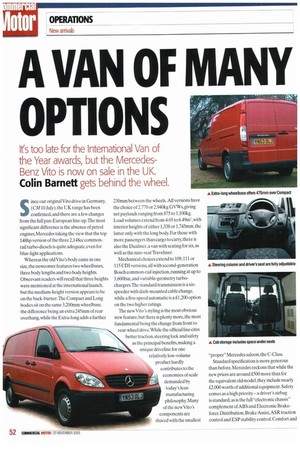A VAN OF MANY OPTIONS
Page 52

Page 53

If you've noticed an error in this article please click here to report it so we can fix it.
It's too late for the International Van of the Year awards, but the Mercedes Benz Vito is now on sale in the UK.
Colin Barnett gets behind the wheel.
Since our original Vito drive in Germany, (CM 10July), the UK range has been confirmed, and there are a few changes from the full pan-European line-up.The most significant difference is the absence of petrol engines. Mercedes taking the view that the top 148hp version of the three 2,148cc commonrail turbo-diesels is quite adequate, even for blue-light applications.
Whereas the old Vito's body came in one size, the newcomer features two wheelbases, three body lengths and two body heights. Observant readers will recall that three heights were mentioned at the international launch, but the medium-height version appears to be on the back-burner.The Compact and Long bodies sit on the same 3200mm wheelbase. the difference being an extra 245mm of rear overhang, while the Extra-long adds a further 230mm between the wheels. All versions have the choice of 2.770 or 2,940kg GVWs, giving net payloads ranging from 875 to 1,100kg. Load volumes extend from 4.65 to 6.49m', with interior heights of either 1.338 or 1,745nun, the latter only with the long body. For those with more passengers than cargo to carry, there is also the Dualiner, a van with seating for six, as well as the nine-seat Traveliner.
Mechanical choices extend to 109,111 or 115 CDI versions, all with second-generation Bosch common-rail injection,running at up to 1,600bar, and variable-geometry turbochargers.The standard transmission is a sixspeeder with dash-mounted cable change. while a five-speed automatic is a £1,200 option on the two higher ratings.
The new Vito's styling is the most obvious new feature, but there is plenty more, the most fundamental being the change from front to rear-wheel drive. While the official line cites better traction.steering lock and safety as the principal benefits, making a unique driveline for one relatively low-volume product hardly contributes to the economies of scale demanded by today's lean manufacturing philosophy. Many of the new Vito's components are shared with the smallest "proper" Mercedes saloon, the C-Class.
Standard specification is more generous than before. Mercedes reckons that while the new prices are around £500 more than for the equivalent old model, they include nearly £2,000 worth of additional equipment. Safety comes as a high priority— a driver's airbag is standard, as is the full "electronic chassis" complement of ABS and Electronic Brakeforce Distribution, Brake Assist,ASR traction control and ESP stability control. Comfort and convenience are aided by fully adjustable steering column and driving seat, electric windows and a combined radio and CD player.
The loadspace comes with a quality phenolic-resin ply floor featuring recessed lashing rings, two side-loading doors and a choice of top-hinged tailgate or 180'-opening twin barn doors as standard.A range of bulkheads and door-glazing options are also available.Two equipment packs can also be specified; Cargo includes load restraint tracks in the floor and body sides with matching ratchet straps,while Top Load comprises roof bars and a ladder rack with roller and straps.
Maintenance intervals are now on the ASSIST variable-interval regime. with major services due at up to 25,000 miles.or annual intervals. Warranty is now three years or 125,000 miles, with 12 years' anti-corrosion cover. Running costs are further eased by lower insurance rates, not least thanks to good security features. Programmable remotecontrol central locking, with separate load space operation is standard.
Driving impression The assembled group of vehicles was limited to manual 109 and 110 CDI Long and Extralong variants. However, as these comprise the majority of examples likely to be sold, certainly as regards the drivelines,it was a useful representation.
We began with a 111 CDI Long in a fairly basic spec:The first impression was of a cab with good-quality fixtures and fittings, although the main dash plastic is harder than it looks. Seats are comfortable without being too soft, and there is a vast array of storage facilities, including a glovebox and dash top pocket. There's access to more storage beneath the passenger seat from t he load space. Some road noise from the rear tyres made its way forward, hut the journey was fairly tranquil.
Despite being challenged by some poorly surfaced roads,the all-independent suspension coped well.As with all of the test vansthis one was unladen bar a quarter-tonne of journalists so the performance was lively. giving the electronic aids plenty to do on the wet, leaf-strewn minor roads.The only drama was negotiating a greasy ford on a tight bend. which provoked a few balletic lurches before the ESP gathered things up.
At higher speeds on better roads the handling was exemplary:The promise of good steering lock from the rwd layout was honoured,as we discovered when recovering from the occasional navigational lapse, with U-turns easily achievable.
Our biggest doubts concern the US-style foot-operated, hand-released parking brake. Although Mercedes is convinced the UK market will accept it this time round,having re-engineered it to hand operation on the last Vito just for us. we're more sceptical. Maybe the new light-vehicle version of Bosch Hill Hold, as standard on the Actros, would be a useful addition? In fairness, it does achieve its aim of improving accommodation without having to leave a big gap between the seats.
Our next drive was in a 109 CDI Long.The lower rating certainly has less surplus power to play with, but was still surprisingly sprightly and would seem lobe perfectly adequate unless you regularly operate at maximum GVW.The £200 glazed bulkhead option virtually eliminates road noise from the rear, albeit at the expense of some seat travel unless you are unduly generously proportioned, we'd recommend the option. •
































































































































































































